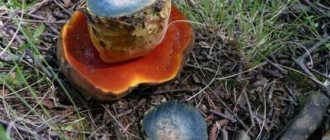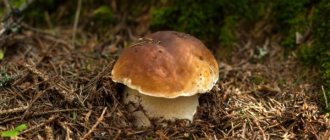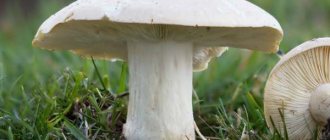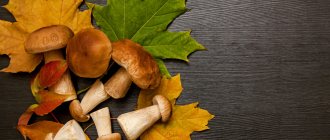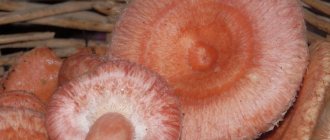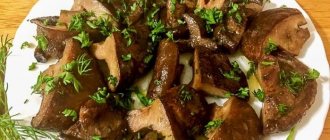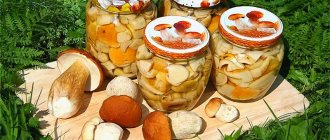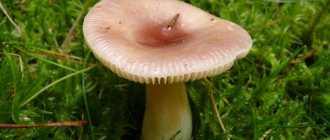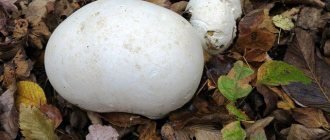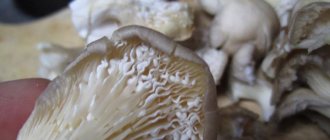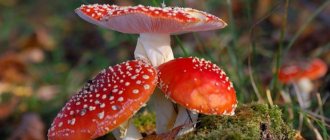How often have you found unfamiliar mushrooms? Surely every lover of “silent hunting” has encountered this. A number of signs will help distinguish edible species from poisonous ones. Let's try to figure out which mushroom turns blue when cut.
Firstly, it should be noted right away that there are many tubular and lamellar species that change the color of the pulp when cut. This occurs due to the oxidation in air of certain substances included in the composition. The mushroom, blue when cut, can be either a tasty boletus or a poisonous false white. The latter is one of the most dangerous, containing a huge amount of toxins and causing severe poisoning.
Why do mushrooms turn blue and how quickly does this happen?
There is an opinion that blueness indicates the presence of dangerous toxins in the fruiting body. In fact, this is not true. All color changes in mushrooms occur due to the fact that natural pigments come into contact with oxygen and oxidize, as a result of which the tissues of the fruiting body change their color.
Changes happen quickly, sometimes instantly. But in different species this process occurs differently: for example, in the satanic mushroom, the cut site first turns blue or green, and later turns red.
Eating
Mushrooms are a healthy and nutritious natural product. They contain a large amount of vitamins, microelements and essential amino acids. Being a low-calorie product, mushrooms are used in dietary and vegetarian nutrition. And their high protein content has made them popular in special sports diets. In addition, the beneficial substances and compounds contained in mushrooms are successfully used in folk and traditional medicine.
Fruit bodies that change the color of the flesh to blue are not always unsuitable and dangerous for consumption.
Can a blue mushroom cause harm to the body?
Almost all bruises are harmless, but there are a few exceptions: Kele's oak (inedible or conditionally edible), gall mushroom (inedible due to its unpleasant taste) and satanic mushroom (poisonous).
They all belong to the Boletaceae family and can be confused with porcini mushrooms and other boletus mushrooms. Only the Satanic mushroom (Boletus satanas) poses a serious danger, it is toxic even after prolonged cooking and causes severe upset of the digestive system. However, no deaths were recorded.
Symptoms of false butterfly poisoning and first aid
False boletus mushrooms do not exist as an independent species. There are no doubles that are dangerous to health. However, it is worth remembering that if a mushroom raises the slightest doubt, it is better not to take it at all than to pay for your greed later.
You can be poisoned by boletus mushrooms only if real mushrooms were collected along the road, near a large industrial enterprise, or in an environmentally unfavorable area. Any mushrooms quickly absorb all toxins, heavy metal salts and other “chemicals”. No amount of soaking or heat treatment can remove them from the fruiting body.
It can also be bad for children, since mushrooms are quite a heavy food, and they should not be included in the diet of a child under 5-6 years old. It is also not recommended to consume mushrooms for pregnant women, nursing mothers and people who have problems with the digestive system.
Varieties, description, place and time of fruiting
Boletus or boletus
A tall mushroom with a slender stalk, grayish or brown, abundantly covered with darker scales. The cap is smooth, hemispherical, up to 15 cm wide. Its color varies among different species of this group.
The black boletus (Leccinum melaneum) has the property of turning blue when broken. This does not always happen; the pulp may not change color. It is interesting that only the stem of the mushroom turns blue, but the flesh of the cap remains white.
Other types of boletus turn pink or even red when pressed, which later darkens. All these mushrooms belong to the second category, they are almost as tasty as boletus mushrooms.
The blackhead's cap is dark brown, almost black, and convex. The underside is tubular, cream or grayish-white in color. The skin is matte, but becomes sticky in wet weather.
Black boletus grows in mixed forests in numerous groups. They form mycorrhizae on birch roots and hide among moss and thick grass.
They can be found along the shores of lakes and swamps, along roads, on lawns, and forest edges. The boletus is widespread throughout Russia, with the exception of the southern and southwestern regions.
The first fruiting bodies of blackheads appear in August, and the peak occurs in September. Individual mushrooms can be seen even in October. The first black boletus mushrooms are a sign that honey mushrooms can soon be collected.
Obabok
Boletus or redhead
The boletus is similar in appearance to the boletus, differing in the color of the cap: it is orange-red, sometimes white, from 4 to 30 cm. The lower surface is tubular, with rounded pores.
The leg of the boletus is light, covered with dark scales. The height is usually 10-15 cm, but can reach 20 cm. It sometimes thickens at the base.
The flesh of the mushroom is white, almost odorless. When cut, most aspen boletuses quickly turn blue, acquiring a beautiful cornflower blue color (the exceptions are colored-legged and pine boletuses), then turn black. Both the stem and the cap can change color.
Boletuses are widespread in Eurasia (Estonia, Latvia, Belarus, Crimea). In Russia, it is often found in the Moscow, Leningrad, Penza, Murmansk regions, Perm Territory, as well as in the forests of Siberia and the Urals.
This mushroom prefers deciduous and mixed forests, young aspen trees (which is why it got its name). Boletuses grow both individually and in groups. Collection time: from the first half of June to October.
Red boletus
Poddubovik or Polish mushroom
Poddubovik is a conditionally edible mushroom with a characteristic feature in the form of non-disappearing bright blue spots over the entire surface. It is often called ink.
It has a brown cap 4-12 cm wide, semicircular, and later cushion-shaped. The lower surface is tubular, yellowish in color, with small pores. They turn blue when pressed.
The leg is 4-12 cm, may be slightly narrowed or swollen at the bottom. Fibrous, yellow or light brown in color with red-brown fibers.
The flesh of the Polish mushroom is fleshy, whitish or yellowish. When cut, the cap becomes deep blue, then light again. The flesh in the stem turns blue, then turns brown.
Despite its name, oakweed does not necessarily grow under oak trees. It often forms mycorrhiza with pine, as well as with beech, spruce, and chestnut.
It is found in coniferous forests, less often in deciduous forests, and can grow on stumps and the bases of trunks. Prefers sandy soils.
Poddubovik is a common mushroom in the northern temperate natural zone. In Russia it is found in the European part, in Siberia, the North Caucasus and the east (Kunashir Island). Season: June to November, often bears fruit later than all other tubular mushrooms.
Polish mushroom
Spruce saffron milk cap
Mushroom from the Russula family. The cap is convex, but becomes concave with age. Diameter: 2-8 cm. Hymenophore lamellar. Color can vary from bright orange to pale pink.
The leg is low, straight, very brittle. Colored the same as the hat. The mushroom abundantly secretes milky orange juice. Has a faint odor reminiscent of fruit.
When damaged or simply with age, the flesh of the spruce camelina acquires a green color. But in conditions of excessive humidity, the mushroom may turn blue. Both the cap with plates and the stem change color.
Camelina grows in groups in spruce and spruce-deciduous forests, preferring illuminated areas and sandy soil covered with pine needles. Found along the edges of swamps.
Spruce saffron milk caps are common in the coniferous forests of Europe, Siberia, the Urals and the Far East. There are not very many of these mushrooms in central Russia, but you can find them. Collection period: from July to the end of October.
Spruce saffron milk cap
Oiler
A mushroom of the Boletaceae family with a specific oily cap that is slippery to the touch. The hat can be convex or flat, in different shades of brown. Sometimes it is connected to the leg with a special protective film. The hymenophore is tubular, yellow or white, and may be descending along the stalk.
The height of the leg is 4-12 cm, it is lighter than the cap, fibrous, with a white filmy ring. At the cut site it may acquire a blue or purple color, darkening gradually and slightly.
Butterfly grows next to coniferous trees, mainly pine and larch. They prefer bright places: edges, clearings, along roads, sometimes under separate trees.
The species is widespread in the moderately cold climate of the Northern Hemisphere, but is sometimes found in the tropics (Africa, Australia). In Russia, boletus grows in the European part, in Siberia, the Caucasus and the Far East. The season is from June to October.
Oiler
Kozlyak or lattice
The goat mushroom is a relative of the oiler. It has a light brown cap, 3-12 cm wide, cushion-shaped. It is sticky to the touch, shiny in dry weather and oily after rain. A tubular layer with large pores of irregular shape, yellow in color.
The stem, 4-10 cm high, is often curved, dense, and differs little in color from the cap. The pulp is elastic and dense, yellowish. When cut, only the stem turns blue, and the cap becomes reddish or pinkish.
The goat grows mainly next to the pine tree, both singly and in large groups. Found in coniferous forests on acidic soils. Prefers wet places, sphagnum bogs.
The species is widespread throughout the northern temperate zone: Europe, the European part of Russia, the Urals, the North Caucasus, Siberia, and the Far Eastern Federal District. Collection time: August – September.
Kozlyak
Gyroporus cyanescens or bruise mushroom
A rare edible mushroom with a pleasant taste. It was listed in the Red Book of Russia, but since 2005 it has been excluded. The cap is yellowish-brown in color, velvety, convex or flat, 5-15 cm wide. The lower surface is tubular with small pores of white or yellowish color.
The leg is thickened at the base, with voids, close in color to the cap or white. In places of damage, all parts of the mushroom turn intense blue, this happens in a few seconds.
Blueberry forms mycorrhiza with birches and also grows under chestnuts and oaks in deciduous and mixed forests with sandy soil. Widely distributed in the temperate zone of the northern hemisphere. It is common in places, but rare in Russia.
His enemies are wild boars that tear apart the mycelium. Careful collection of fruiting bodies does not harm them, but, on the contrary, promotes growth and an increase in habitat. The taste of gyroporus is close to porcini mushroom. Fruiting season: July to September.
Gyroporus blue
Olive brown oak (Boletus luridus)
An edible boletus mushroom. The light brown cap with a diameter of 5-20 cm has the shape of a hemisphere, sometimes opening to flat with age. When touched, dark spots remain on the velvety cap.
The leg has a tuberous thickening at the bottom, 15 cm in height. the color is yellowish with a convex red-brown mesh pattern. The pulp is dense, yellowish, red at the base. When cut, the mushroom turns blue, then turns brown.
Olive-brown oakweed grows under oaks, beeches, and birches. A heat-loving mushroom, but rarely found at the latitude of St. Petersburg. Quite common in Europe, the Caucasus, and less commonly in Western Siberia and the Far Eastern Federal District. Can be found isolated in Eastern Siberia (Krasnoyarsk Territory). Harvesting season: May – September, bears fruit most actively in August.
Oak tree olive-brown
Speckled Oak (Boletus erythropus)
The dark brown cap with a diameter of 5-15 cm has a convex hemispherical shape. When pressed, it darkens, matte, and the texture of the skin resembles suede.
The leg is thick and tuberous, red-yellow in color, reaches 5-10 cm in length. The surface is uneven, covered with small scales and specks.
The flesh of the speckled oak is dense and fleshy. It is bright yellow in the cap and reddish in the stem. When pressed or cut, it quickly turns blue, and the tubular layer of the mushroom also reacts.
Speckled oakweed is found in oak, spruce and mixed forests. Prefers acidic soils, marshy areas, and moss. Distributed in Europe, Eastern and Western Siberia, the Caucasus and the south of the Far East. Rarely found at the latitude of St. Petersburg. Fruiting season: May to October, peak in July.
Speckled oakweed
Do boletus turn blue when cut?
The question of whether oilcans can turn blue in places of damage worries many mushroom pickers. But, in general, a change in the color of the fruiting body when damaged is characteristic of almost all representatives of the mushroom kingdom, without exception. It’s just that in some species it is almost invisible, in others the color may be slightly different, and in others (in particular, representatives of the Boletaceae family) it can be especially pronounced.
Below is a photo illustrating this phenomenon:
Features of preparing edible bruises
Edible bruises can be used in cooking immediately fresh, since most often they do not have a pronounced mushroom smell. They are also great for canning or drying for the winter. They say that bruises make the most delicious mushroom caviar and sauces.
But the bruise is still not popular among housewives in our country because of its specific feature of changing color, which can be frightening. There are several processing methods to avoid mushrooms turning blue.
Cleaning
Before cooking, the bruises are cleaned of soil and forest debris, the lower edge of the leg is cut off and washed in cool water. Everything is standard, as with any other mushrooms. Large bruises are best cut in half.
IMPORTANT: To prevent mushrooms from turning blue, it is recommended to place them in salt water immediately after picking. Then it is drained and you can cook it: fry or boil. If the mushrooms have already darkened, they can be soaked in a 0.5% citric acid solution.
Cooking
The soup made from bruises is not blue, but regular - very tasty, with a rich aroma of mushrooms. The recipe can be made more interesting by adding dried fruits: prunes and raisins.
Ingredients:
- bruise mushroom – 4-5 pcs. fresh or 25 g dried;
- water;
- potatoes - 5 tubers;
- onions – 2 onions;
- vegetable oil - a couple of tbsp. l.;
- pitted prunes – about 50 g;
- raisins – 80 g;
- wheat flour – 1 tbsp. l.;
- parsley - a few sprigs;
- salt – 1.l.
How to cook:
- Thoroughly clean fresh bruises, soak dried ones for half an hour to an hour in cool water.
- Place in a saucepan, add 2-3 liters of water, which should completely cover the mushrooms.
- The mushrooms should boil over medium heat, then cook for about 10 minutes. The first liquid from the pan must be drained, the bruises washed and refilled. After boiling, cook the mushrooms for another 20 minutes.
- Remove the bruises and cut into cubes.
- Peel and chop potatoes and onions.
- Chop the dried fruits and pour boiling water for 10 minutes.
- Add dried fruits and potatoes to the broth, cook for 15 minutes. Meanwhile, fry the onion and flour in oil. Add some mushroom broth to the pan and bring to a boil.
- Then combine the onion frying, fruit bodies, salt and spices in a saucepan and let it brew. Garnish the soup poured into bowls with herbs.
Pickling
This method is well suited for blue mushrooms, since they darken less with vinegar.
Ingredients:
- bruises – 1 kg;
- vinegar - 2 tbsp. l.;
- garlic – 2-3 cloves;
- salt, sugar - 1 tbsp each;
- dill - several sprigs;
- salt, sugar - 1 tbsp each;
- bay leaf – 2-3 pcs.;
- black pepper - half tsp. or 5 peas;
- cloves – 3-4 pcs.;
- bay leaf – 2-3 pcs.
How to cook:
- Clean the bruises, cut them and boil them, draining the water once. Before this, it is recommended to keep them in cool water for a day, changing it periodically.
- Rinse the boiled mushrooms and soak again in cold water.
- Meanwhile, prepare the marinade: dissolve vinegar, salt and spices in water.
- Rinse the mushrooms again, add brine and put on fire. Boil for about 10 minutes.
- Place the mushrooms in a special sterile container, add brine, add coarsely chopped garlic and herbs. Leave for at least 1-2 days in the refrigerator.
Bruises can last up to two weeks in this form. If you preserve them in jars, the shelf life increases to a year.
Freezing
Bruises can be frozen whole or sliced. To do this, you need to choose young and healthy mushrooms, thoroughly cleaned. Shelf life in the freezer is 6-8 months.
Frying
After special preparation of bruises (soaking or boiling), they are suitable for frying, like regular edible varieties.
Some types (for example, poddubniki) can be cooked immediately after washing - the mushrooms secrete juice, which makes the dish even tastier.
Ingredients:
- fresh bruises – 0.5 kg;
- onions – 2 pcs.;
- green onions - a few feathers;
- walnuts (shelled) – 1 tbsp.;
- butter – 80 g;
- apple cider vinegar – 2 tbsp. l.;
- parsley, cilantro - a few sprigs;
- salt, pepper - to taste.
How to cook
- Wash and clean the bruises, cut into slices.
- Season thoroughly with salt and fry in oil along with chopped onion.
- Drain the juice that will stand out and add a couple of tablespoons of apple cider vinegar and pepper to it. Pour this sauce over the fried bruises.
- Add nuts and chopped herbs, let cool.
- When serving, decorate the mushrooms with herbs.
Pickling
All edible mushrooms can be salted, but lamellar mushrooms (pigs, russula, chanterelles, etc.) are best suited for this. Tubular species become flabby after salting.
Considering that almost all bruises belong to the second group, pickling is better suited for them. Of course, you can salt them, but select young specimens.
Ingredients
- bruises – 10 kg;
- coarse salt – 435 g;
- vegetable oil – 3 tbsp. l.
- water.
How to cook
- Sort the mushrooms, rinse and peel.
- Boil for a few minutes, stirring.
- Drain the liquid and cool the mushrooms in cold water. Dry.
- Place the first layer of bruises in a pickling container, caps up, and sprinkle thickly with salt. Also add the remaining mushrooms in layers.
- Cover the mass with gauze and press down with a flat dish or lid, and place a small weight on top.
- After a few days, a salt coating forms on the surface of the workpiece. Drizzle with vegetable oil.
- Store the workpiece at low temperatures, for example, in a cellar.
Drying
This is one of the most successful and simplest ways to prepare mushrooms. They acquire a richer and deeper aroma, and are also better absorbed. Boletus mushrooms are especially good here (among the bruises these are Giroporus blue, Olive-brown Dubovik, Speckled Dubovik, Podbovik, etc.).
Many people note that when dried, they are indistinguishable in taste from porcini mushrooms.
Canning for the winter
Pickled mushrooms are rolled into sterilized jars directly with liquid. Salted foods must be prepared before canning.
Ingredients:
- salty bruises;
- glass jars of the required volume;
- water;
- salt (at the rate of 30 g per 1 l);
- vinegar essence (3-5 g per 1 liter of brine).
How to cook:
- Prepare the brine: dissolve 1 tbsp. l. with a heap of salt in 1 liter of boiling water, add vinegar essence.
- Pour hot brine over bruises.
- Sterilize jars in a way convenient for you (over steam, in boiling water, in the oven, microwave or dishwasher). Liter containers should be processed for 25-30 minutes.
- Pour the mushroom mixture into jars and seal tightly. Turn upside down and let cool.
Warning: dangerous look-alikes
If you don’t know which mushroom turns blue when cut, but you come across such a handsome one on your way, be extremely careful. This is the so-called “satanic mushroom”, or false white. Outwardly, it really resembles a boletus. The same dense fleshy leg, convex cap, but there are a number of differences! The porcini mushroom does not change color when cut. The flesh of the poisonous twin instantly turns blue or pink. In addition, the leg of the satanic mushroom is covered with a pronounced mesh, and the color is much brighter than that of the boletus mushroom.
Another false white is bittersweet. It is much more difficult to get poisoned due to its taste. Compared to the porcini mushroom, bitterling has a thinner stem, blue or pinkish flesh and a disgusting bitter taste.
Poisonous and inedible types of mushroom
There are much fewer inedible mushrooms that turn blue when cut than edible ones. That is why, in order not to make mistakes, it is important to know them.
Kele's Oak (Boletus queletii)
A mushroom from the genus Borovik, inedible (although some sources classify it as conditionally edible). Externally similar to the satanic mushroom. The cap is brown, convex, 5-15 cm in diameter. The stem is thickened downward, smooth, yellow.
When pressed, the stem and tubular layer of the Kele oak instantly turn blue.
This mushroom is relatively rare; it can be found in the deciduous forests of the Caucasus, less often in the Far East. The Kele dubovik prefers acidic and infertile soils, moss and short grass. Fruiting time: from May to October.
Dubovik Kele
Satanic mushroom (Boletus satanas)
It also belongs to the boletus species and is similar in appearance to other representatives of this genus. In its raw form, the mushroom is poisonous, and even after heat treatment it can cause a serious disorder with characteristic symptoms of poisoning.
The satanic mushroom has a massive convex cap with an uneven surface, grayish in color. Sometimes there are huge specimens (up to 30 cm).
The leg is thick, ovoid, red in color. When cut, the color of the pulp turns blue within a few minutes, then red.
Satanic mushroom
Gall mushroom or mustard
A tubular mushroom, inedible due to its bitterness, which gives it its name. When cooked, the unpleasant taste of bittersweet only intensifies. There is an opinion that it greatly harms the liver, but symptoms of poisoning do not appear immediately.
Another name for this species is false white, because. due to their external similarity, they can be confused. The bitterling cap is spongy, light brown, smooth. The leg is massive and fibrous.
The gall mushroom grows on all continents. Prefers coniferous forests and acidic fertile soils. It is found everywhere in Russia. It actively bears fruit from the end of June to October; with early frosts, it completes the growing season in September.
Bile mushroom
How is boletus useful?
In addition to their incredibly beautiful appearance, boletus boasts a rich set of nutrients. They include:
- Vitamins (PP, E, C, B1, B2).
- Minerals (magnesium, sodium, phosphorus, iron, calcium).
It is noteworthy that in terms of the content of vitamin “PP”, boletus mushrooms are not much inferior to such a product as beef liver, and the amount of vitamin “B2” in these mushrooms is comparable to legumes. Boletus contains a lot of proteins, which are digested, although worse than proteins of animal origin, but at the same time they are a source of a number of essential amino acids. Eating boletus will be useful for people suffering from inflammatory diseases, anemia, and also during the recovery period after infectious diseases.
Interesting Facts
- The older the bruise, the richer the blue color of the cut.
- Blue spots on a mushroom are not always normal. They may say that the copy is simply old and damaged, and it is better to throw it away.
- The mushroom Giroporus blue gave the world a unique antibiotic - boletol.
- There are also species completely colored blue: for example, the bright blue spider web (Cortinarius eucaeruleus). True, it has no nutritional value.
- Natural dyes are made from some varieties of gyroporus (Gyroporus cyanescens var. violaceotinctus). In Norway, they have been used to dye wool yarn since ancient times.
Do boletus turn blue when cut?
The question of whether oilcans can turn blue in places of damage worries many mushroom pickers. But, in general, a change in the color of the fruiting body when damaged is characteristic of almost all representatives of the mushroom kingdom, without exception. It’s just that in some species it is almost invisible, in others the color may be slightly different, and in others (in particular, representatives of the Boletaceae family) it can be especially pronounced.
Below is a photo illustrating this phenomenon:
Where does it grow
The blue mushroom grows in deciduous and mixed forests. Prefers birch trees, forming mycorrhiza with their roots. That’s why it’s also called birch gyropor. It can bear fruit near oak, chestnut, and in coniferous forests. You can meet him in the meadow, away from the trees. Widely distributed throughout the middle zone, Europe and North America. In Russia, the bruise can be found in birch groves and along roads. It is not found in the southern regions, as it does not tolerate hot climates.
Gyroporuses bear fruit from early July to September. In warm autumn - until mid-October. They usually appear on the north side of the tree, under the leaves, as they do not like bright sun. They grow singly or in small groups, but away from each other. They like sandy, moist and acidic soil.
Bruise is a rare species; in some regions its collection is prohibited. If you want to enjoy an exotic dish, you can take several fruits. Just be sure to cut 1-2 cm from the root with a sharp knife. Do not pull it out of the ground, as this damages the mycelium.
